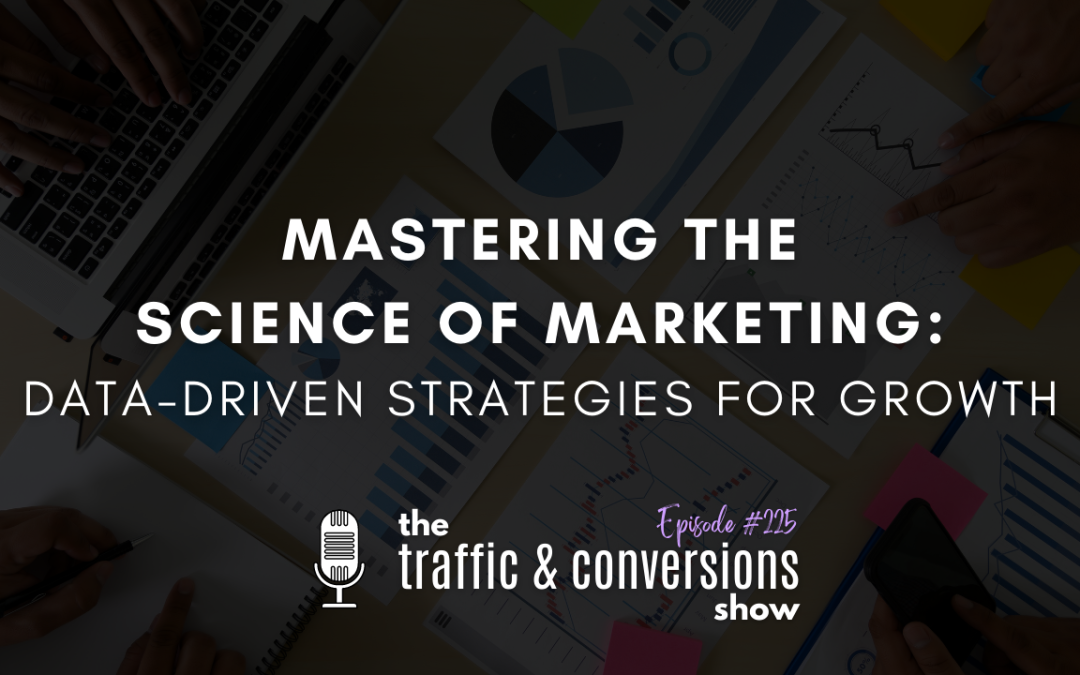It can feel frustrating not knowing what’s going wrong with your ads or funnels and why they’re just not converting. All you want is a way to push through this revenue plateau and move to the next level. But no matter where you are in revenue generating, your emotions always start coming into play. Have you ever started from scratch again, just because the first or second thing didn’t work? We’ve all been there!
But when you detach the emotion from the outcome, stop making emotional driven decisions for your marketing (and your entire business!), and unleash the power of data, you can really achieve marketing excellence. Today we’re learning why data-driven marketing matters, how to navigate data analytic tools, and how you can decipher marketing metrics for strategic insight.
Why data-driven marketing matters
In today’s fast-paced digital world, businesses are inundated with information, and so are our clients. Data is being generated at an unprecedented rate, from website traffic, to social media interactions like customer behavior, to campaign performance. This is where data-driven marketing steps in and transforms this sea of data into actionable insights.
Data analytics tools serve as the foundation of this transformation. They provide us with a treasure trove of information that can illuminate the path to smarter, more informed decisions. These tools allow us to slice and dice the data, uncover patterns, trends, and correlations that might be otherwise be missed.
So with the power of data analytics, marketing goes from being essentially a shot in the dark, to a very calculated and strategic endeavor. Data-driven marketing doesn’t just rely on our gut feelings or those instincts. It is fueled by concrete data information. This means that the strategies and tactics that you choose to deploy are based on evidence rather than guesswork. It’s like having a compass that guides you through the ever evolving landscape of consumer behavior and market trends.
Navigating data analytic tools
When it comes to data analytic tools, there are a lot available to you and more and more coming out each day. These tools are the compasses that help us navigate the intricate pathways of consumer insights and behaviors. They empower us to uncover valuable data points that are instrumental in understanding our audience, refining our strategies, and ultimately propelling our businesses forward.
Google Analytics
A staple for many marketers is Google Analytics. This tool provides a panoramic view of key metrics such as page views, bounce rates, conversion rates, demographics, and all of the things that give important insights into your user behavior, which can help to shape your digital strategy.
Customer Relationship Management (CRM) Systems
Another tool in your toolbox is a customer relationship management system (often referred to as a CRM). The CRM helps us dive into the intricate web of our customer interactions. These platforms offer a centralized hub where you can track leads, sales and customer interactions. It provides insight into engagement with your customers, how you are connecting with them, and what they are responding to. This invaluable data enables you to personalize your marketing efforts, anticipate customer needs, and build long lasting relationships. It gives you the ability to zoom in on a user’s behavior, and offers a visual representation of how users interact with your website. You can discover what the customer journey looks like, how they are navigating through your funnels, where they are stopping and clicking on a page or email, and what actions they are taking. All of this data helps you to optimize your page layouts, write your websites and really enhance the user experience.
Social media analytics
These gems uncover how your audience engages with your content across all your platforms. Whether it’s Instagram, Facebook, or Twitter, your social media accounts should have these analytics, and you should be using them to analyze what data comes in. It helps you understand which posts are resonating with your audience, the best times to post for maximum impact, and so much more.
These tools are right at your fingertips and the beauty of them is in their ability to transform raw data into actionable insights. They unveil patterns, trends, and correlations that inform your marketing decisions. By diving into these insights, you can fine tune your strategies, tailor your messaging, and allocate resources more efficiently, whether that’s financial resources or your time. For example, if you know that your ads are working, then you can put more money in it. If they’re not working, you might stop putting more money in, figure it out, and then go back in.
As you navigate this tool set, remember that it’s not just about data for data’s sake. It’s about understanding your audience at a deeper level. When you know what your customers want, how they behave, and what triggers their actions, you hold the keys to delivering experiences that truly resonate.
Deciphering marketing metrics for strategic insight
I know looking at your numbers is not what most visionaries like, but your marketing metrics are more than just numbers. They are the windows into the effectiveness of your strategies and overall the health of your business. Marketing metrics are like signposts on a journey, telling you where you are, where you’ve been, and where you’re heading. And just as a skilled navigator can use these signs to chart a successful course, a savvy marketer can use their metrics to fine tune their approach to maximize impact, revenue, and profit.
Here are some of the key metrics that form the backbone of data-driven marketing:
These reveal the percentage of visitors who take the desired action that you want them to take, e.g. making a purchase or signing up for a lead magnet. A higher conversion rate indicates that your messaging resonates with your user and that your user experiences are on point.
This metric helps you understand the long-term value each customer brings into your business. Armed with this insight, you can make informed decisions about customer retention strategies, product development, and even customer segmentation.
- ROI (return on investment)
This metric reveals the financial impact of your marketing efforts. It helps you determine if you are getting the bang for your buck and assists in making resource allocation decisions.
Metrics on their own are informative, but the real magic happens when we interpret them to uncover actionable insights. For example, a decrease in conversion rates might indicate that your landing page needs some work. A rising customer lifetime value is a great sign that your customer loyalty programs are working. And if your ROI is not meeting expectations, it might be time to reevaluate your marketing channels, strategies, or even if you have the right team member doing that job. Interpreting metrics is more than understanding what the numbers mean–it’s about translating those insights into actionable steps.
Conclusion
Data-driven marketing isn’t just a luxury–it is a necessity in a world saturated with information. Those who harness the power of data will be the ones who rise above the noise.
Are you ready to take your business to the next level and navigate your way through data-driven marketing?
I’d love to go on that journey with you, so head over to predictablegrowthaccelerator.com and let’s grow your business together.


